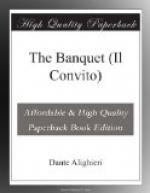Such virtue shows its good
To others’
intellect,
For when two things agree
in one,
Producing one
effect,
One must from other come,
Or each one from
a third,
If each be as each, and more,
then one
From the other
is inferred.
Where it is to be known that here one does not proceed by an evident demonstration; as it would be to say that the cold is the generative principle of water, when we see the clouds; but certainly by a beautiful and suitable induction. For if there are many laudable things in us, and one is the principle or first cause of them all, reason requires each to be reduced to that first cause, which comprehends more things; and this ought more reasonably to be called the principle of those things than that which comprehends in itself less of their principle. For as the trunk of a tree, which contains or encloses all the other branches, ought to be called the first beginning and cause of those branches, and not those branches the cause of the trunk, so Nobility, which comprehends each and every Virtue (as the cause contains the effect) and many other actions or operations of ours which are praiseworthy, it ought to be held for such; that the Virtue may be reduced to it, rather than to the other third which is in us. Finally it says that the position taken (namely, that each Moral Virtue comes from one root, and that such Virtue and Nobility unite in one thing, as is stated above, and that therefore it is requisite to reduce the one to the other, or both to a third; and that if the one contains the value of the other and more, from that it proceeds rather than from the other third) may be considered as a rule established and set forth, as was before intended.
And thus ends this passage and this present part.
CHAPTER XIX.
Since in the preceding part are discussed three certain definite things which were necessary to be seen before we define, if possible, this good thing of which we speak, it is right to proceed to the following part, which begins: “Where Virtue is, there is A Nobleman.” And it is desirable to reduce this into two parts. In the first a certain thing is proved, which before has been touched upon and left unproved; in the second, concluding, the definition sought is found; and this second part begins; “Comes virtue from what’s noble, as From black comes violet.”




